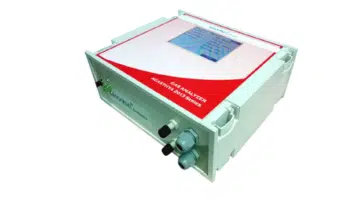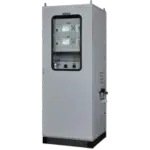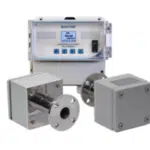CO2 analyzer – Analysis and Applications
According to the 5th IPCC report, carbon negative technologies are necessary for the scenarios to achieve a lower than 2 degrees increase in global temperature before the end of the 21st century. Apart from brutal geo-engineering methods, the application of Carbon Capture and Sequestration (CCS) to renewable fuels, also known as Bio-CCS or Bioenergy with CCS (BECCS), appears to be the most promising approach. As a renewable energy, biogas produced from anaerobic digestion and landfill is playing a more and more important role in the energy market.
Biogas has been considered as the cleanest renewable fuel for transportation by the United States and the European Union. However, since raw biogas mainly consists of methane (CH4 ~ 65vol%) and carbon dioxide (CO2 ~ 35vol%), an upgrading process is normally needed to remove CO2 and other unwanted impurities before it can be used as vehicle fuel. If the CO2 removed from the raw biogas can be captured and stored, the negative CO2 emission can be easily realized at a low cost as CO2 is the byproduct of upgrading.
- According to a report released recently by Navigant Research, the global biogas industry has an astounding nearby future, at least for the next ten years, that the annual global raw biogas production will exceed 56,6 billion cubic meter by 2024
- Due to the rapid growth of biogas upgrading, there is a huge potential for CO2 capture. For example, assuming 50% of raw gas is upgraded would result in a CO2 capture of 19,4 Mton. Capturing CO2 from biogas upgrading can be categorized as pre-combustion capture. Different technologies for pre-combustion CO2 capture have been reviewed in our previous work
- According to the conclusion, amine based chemical absorption (Pre-CA) is the most suitable technology, considering the CO2 purity, CO2 capture ratio and efficiency. The advantage lies in small capture systems and low capture costs. However, this route can only achieve a low carbon capture rate as the carbon in CH4 is not captured. Depending on how biogas is utilized, there are also other routes to capture CO2 from biogas, for example when raw biogas is directly used to produce power and heat, the post-combustion capture and oxy-fuel combustion capture can be applied for CCS as well, giving the opportunity to move the CO2 capture plant from the biogas producer site to the user site. Even though engines and gas turbines can reach higher efficiency by using upgraded biogas, it is not mandatory to upgrade raw biogas
- Post-combustion capture means capturing CO2 from the exhaust gas after biogas is burnt in the combustor; and oxy-fuel combustion (Oxy) capture means burning biogas in a nitrogen free environment using pure oxygen and capturing CO2 through simply condensing exhaust gas to remove moisture. As the carbon contained in CH4 will be captured as well, the advantage of post-combustion capture and oxy-fuel combustion capture is the larger CO2 capture rates in comparison to that achieved through biogas upgrading. Similar to natural gas combustion, using biogas as fuel results in a low CO2 content in the exhaust gas. Therefore, for the route of postcombustion capture, the common CO2 capture technology is chemical absorption (Post-CA). Currently, most of the studies about capturing CO2 from biogas focus on how to improve the efficiency of biogas upgrading
- There has not been a comprehensive analysis from the perspective of overall CO2 emission reduction during an energy conversion. To bridge the knowledge gap, the present study aims at assessing the aforementioned technologies for CO2 capture from both technical and economic points of view. Results will provide insights and give guidelines for the selection of CO2 capture technologies to achieve a cost-effective negative CO2 emission
Other Applications of CO2 gas analyzers
The usage of CO2 analyzers can be found in varied fields. Let us find out a few.
- As far as landfill gas production and agriculture are concerned, the level of carbon dioxide that is produced is required to be monitored. As such, the same is used in various courses of operations.
- In furnaces, boilers, and combustion engines, carbon dioxide is a by-product that is produced by machinery and equipment processes. A CO2 gas analyzer helps in determining the amount of Combustion efficiency
- In the process of gasification, a CO2 analyzerhelps in monitoring the amount of the gas when the conversion of biomass materials into products takes place.
How does the CO2 analyzer work?
The process works in the following way-
- Since the instrument depends on NDIR sensors emitting at particular wavelengths of infrared radiation, the wavelengths are seen to pass through a sample tube analyzed as well as a reference containing a non-absorbing gas.
- All hetero-atomic gases absorb light energy in the infrared region at specific wavelengths These are dependent upon the chemical composition of each type of gas The level of absorption is proportional to the mass of the gas present.This characteristic is utilized in infrared gas analysis (IRGA) benches. The benches incorporate a source of infrared energy (usually in the form of a heated filament), which is then optically filtered to reduce the radiation spectrum to that of the absorption band of the gas being measured.
- The CO2 analyzer will be useful in detecting the presence of gas concentration and measuring the amount in ppm or parts per million.
Types of CO2 gas analyzers at Bhoomi
Catch a glimpse of the types of analyzers used by Bhoomi in this context. They are as follows-
- Syn Gas Analyzer BI 7200
- Gas Analyzer BI 7210
- Producer Gas Analyzer BI 7220
- Lanfill Gas Analyzer BI 7100
- Portable Syn Gas Analyzer BI 7230
With the state-of-art technology and processes, the company ensures that the optimum usage of these analyzers is carried out.



